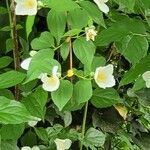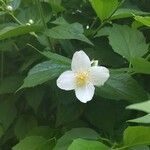Shrubs, 20–40 dm. Stems brown, gray, or stramineous, branched, 20–40 dm, glabrous or very sparsely strigose, especially at nodes; bark reddish, exfoliating or flaking; branches erect to arching; axillary buds hidden in pouches. Leaves: petiole 1–8 mm; blade broadly lanceolate to broadly ovate, or narrowly to broadly elliptic, (3.5–)5–12(–14) × (1.4–)2–5.3(–7) cm, herbaceous, base narrowly cuneate to rounded, margins entire or irregularly to regularly serrate, crenate, or dentate, plane, abaxial surface usually glabrous or moderately strigose, rarely moderately to densely strigose-tomentose in main vein axils, sometimes sparsely strigose on main veins, rarely sparsely strigose on secondary and tertiary veins as well, adaxial surface glabrous or very sparsely strigose, especially near base and margins. Inflorescences cymes or racemes, or flowers solitary, 1–3(–9)-flowered, proximal 2 flowers sometimes in axils of nearly normal to much reduced (bracteal) leaves, if 1-flowered, with articulation between peduncle and pedicel revealing that it is a 1-flowered cyme by reduction. Pedicels 3–8 mm, glabrous or slightly strigose. Flowers: hypanthium usually glabrous, rarely moderately strigose; sepals ovate or ovate-lanceolate, 7–14 × 5–8 mm, apex acuminate to acute, abaxial surface usually glabrous, rarely moderately strigose, adaxial surface glabrous except densely villosulous distally; petals white, oblong, obovate, or orbiculate, 15–25(–30) × 10–22 mm; stamens 60–90; filaments distinct, 5–11 mm; anthers 1–1.5 × 1 mm; styles 4, connate proximally, cylindric, 10–16 mm, lobes 4–8 × 0.8–1 mm; stigmatic surfaces 3–4.5 mm. Capsules obconic to obovoid, 10–13 × 7–10 mm. Seeds caudate, 2–3 mm. 2n = 26.
More
Arching shrub 1–3 m; bark of young twigs brown, exfoliating the second year; lvs ovate to oblong, 4–8 cm, toothed or entire, acuminate, rounded to acute at base, glabrous, or very sparsely hairy beneath; fls in cymules of 3 or solitary, 3.5–5.5 cm wide; hypanthium, pedicels, and outer side of sep glabrous; styles separate above; seeds long-tailed; 2n=26. Streambanks and moist hillsides or cliffs, chiefly in the mts.; e. Pa., Va. and Tenn., Ga. and Ala., sometimes escaped from cult. northward. May, June. (P. grandiflorus)


